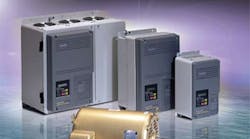Cutting-edge technology can take many applications to new levels of innovation, but established designs have their place, too. Soft starters are one such component. They've been around for decades, but continue to optimize performance on many systems. Their main function is to make motor starting more gradual, so that when systems are fired up from standstill, the motor and connected power transmission components accelerate gently.
The simplest option for feeding power to a motor is a direct line connection. In fact, it's usually more economical to power small motors through a simple contactor. This arrangement is more common with smaller motors that don't run the risk of overdrawing voltage. But sudden starts can jar motors, as well as connected power transmission components downstream.
Soft starters, also called reduced voltage starters, are a more sophisticated choice. Most sophisticated are variable frequency drives. “Now, VFDs are appropriate for more precise, sophisticated applications. But say a motor is used in an application where it's only started a couple times an hour, and is just used at its full speed,” says Jeff Lovelace of Baldor Electric Co., Fort Smith, Ark. “If the application doesn't necessitate shaped voltage and current profiles, a soft starter is most appropriate. They're less costly than VFDs, and particularly for motors 25 hp and above, the cost difference between a soft starter and an inverter is dramatic.”
Also, VFDs can degrade motor insulation with harmonics, so that some motors are incompatible with VFDs. It's a level of complexity that many systems don't require.
Soft-starter options
Soft starters can run open or closed loop. On open-loop systems, the start voltage profile is programmed to follow a predetermined ramp, independent of drawn current or motor speed. A good setting feeds at least breakaway torque to the motor at start; otherwise, the motor starts with insufficient torque, does not spin, and just generates heat. Actual starting motor torque is a function of both start and line voltage, and motor design.
Here's the catch: Open-loop soft starters make motion more gentle, but cannot generate any specific torque, and ramp to full voltage even if attached loads are jammed. In contrast, closed-loop starters monitor output and dynamically adjust input voltage until a target is reached. Some units monitor motor speed, and then adjust voltage to maintain a constant acceleration.
Other voltage-ramp systems monitor current on one phase, compare it to a set point, and then pause ramping if current exceeds it. More sophisticated systems monitor current on all three phases and dynamically change output voltage to match current to a predefined profile.
Constant-current starters rapidly increase output voltage until the required current is delivered to the motor. Then they adjust voltage while the motor starts, until either full voltage is reached, or a motor overload protection goes into action.
More suitable on machines with varying onset torque requirements (like load conveyers) are current-ramping soft starters, which take current from an initial start value to a preset limit over a period of time.
The third closed-loop option is torque control starters, which mathematically model motors, monitor dynamic requirements, and then calculate motor torque output. This value is then used as feedback to control the start voltage applied to the motor.
Torque-control starters control acceleration best, because unlike voltage and current-controlled systems, they start with the least possible current. Also, they ramp linearly and do not exhibit peaking or excessive current.
Big help for big applications
Because soft starters reduce current inrush, they're particularly useful on larger applications, where large inrush currents can actually damage systems. Any application that is very hard to get going — for example, a hammer mill with a very high inertial load — greatly benefits from the added protection.
“Generally speaking, soft starters are most common on applications using 75 hp or above,” says Lovelace.
Paper and grinding-mill machines are other common soft-start applications, where the equipment must reach full load within a specific time, to prevent damage to other equipment in the drive train. For example, on paper dryers, many heated cylinders several feet in diameter dry paper at thousands of feet per minute. To avoid excessive gear teeth stress on the units, maximum acceleration must be limited.
“Installing soft starters on a factory's largest motors can even allow the facility to successfully operate with smaller lines from the power company,” adds Lovelace. “It also helps companies avoid peak demand surcharges: A 200-hp motor normally pulls at least 1,200 or 1,300 A. On the other hand, a motor on a soft starter gets away with using only 300 or 400 A — so the power company doesn't register (or charge for) any big surge on their system.”
Resources: baldor.com/products • softstartdirect.com • emersonct.com • lmphotonics.com • danfoss.com
The real strength of soft starters is that they're simple:
“We have analog and digital soft starters,” says Lovelace. “The analog version is from 1980 and has changed little. It has four potentiometer settings and two switches, which, 90% of the time, need only rare customer changes. The digital version has a keypad interface, and lots of bells and whistles. But our sales for 2007 were about 40/60 between analog and digital — so simplicity is still a factor.”
The switches that make it happen
In soft starters, it's solid-state switches (with no moving parts) that control current flow (and voltage) to the motor. They are phase controlled — turned on for a part of each cycle — and adjusting the firing angle adjusts average output. Thyristors called silicone-controlled rectifiers (SCR) are most common. They can control one or two motor phases to reduce torque on those — but current in these setups is not optimized. A better system is a six-SCR control that generates symmetrical output and reduces the effects of supply disturbances and harmonics.
Controlling output voltage with solid-state switches boosts efficiency because of their low on-state voltage. And with control electronics, this can be automatic: Microprocessor controls are replacing op-amp and other older controls here.
